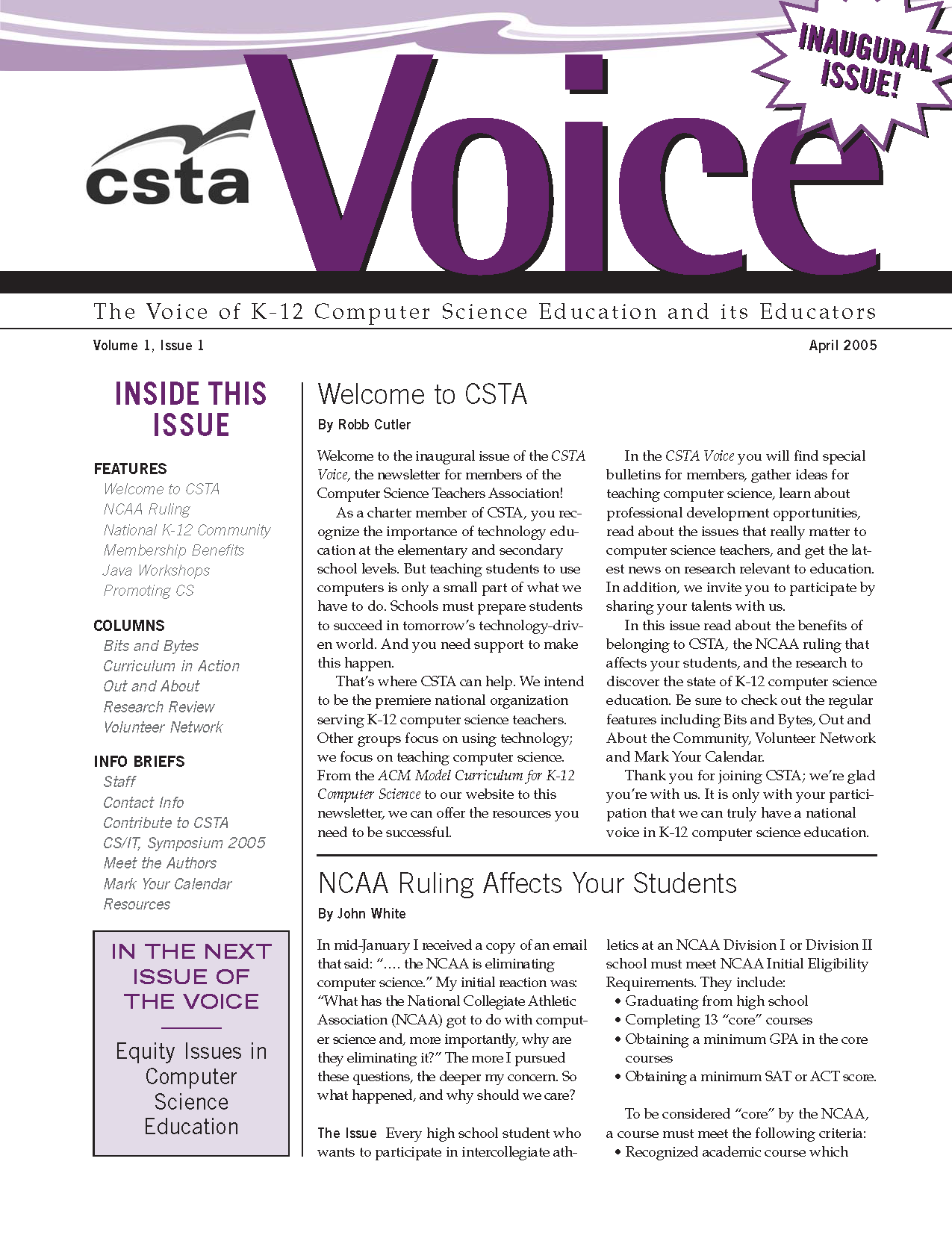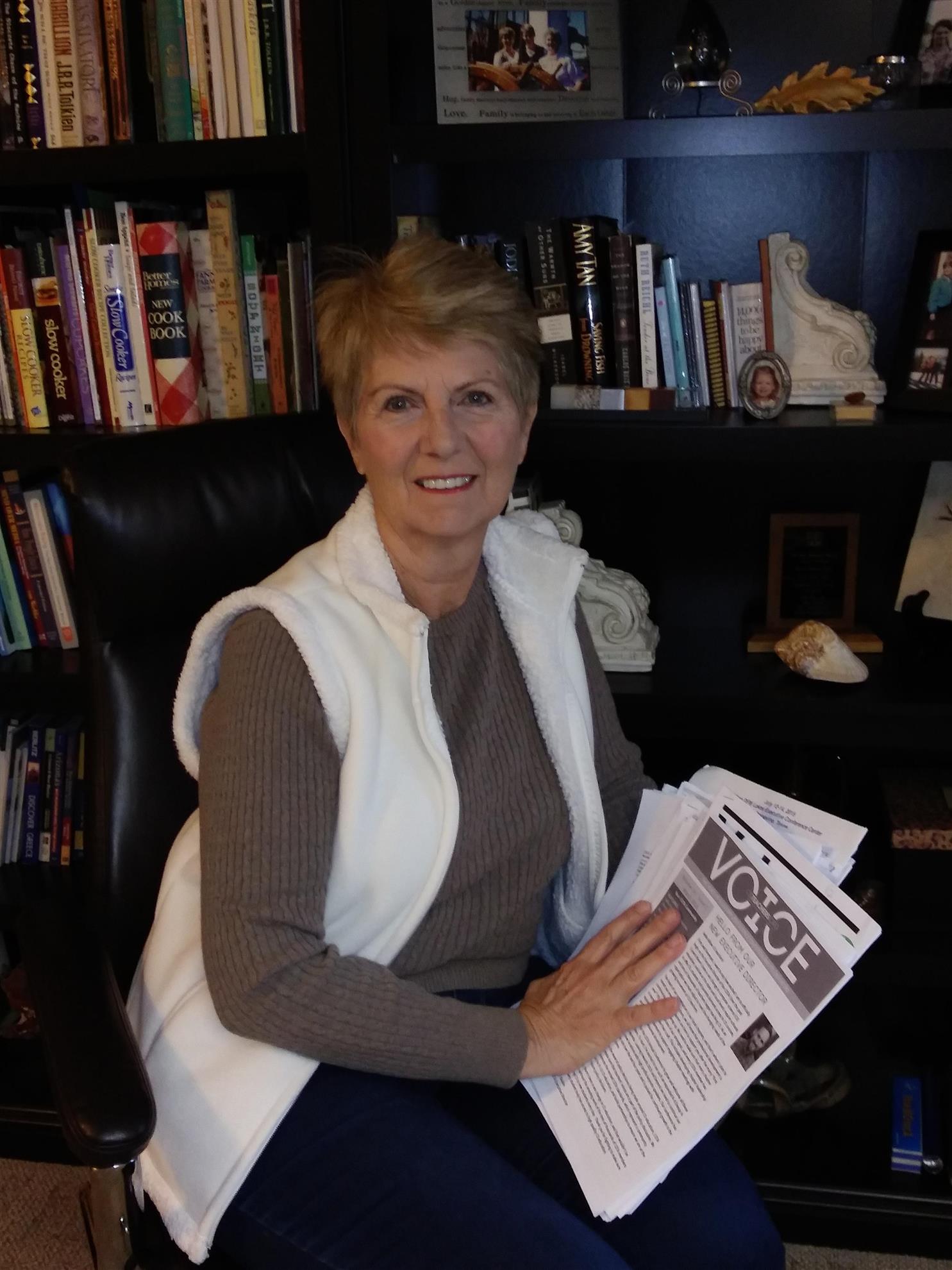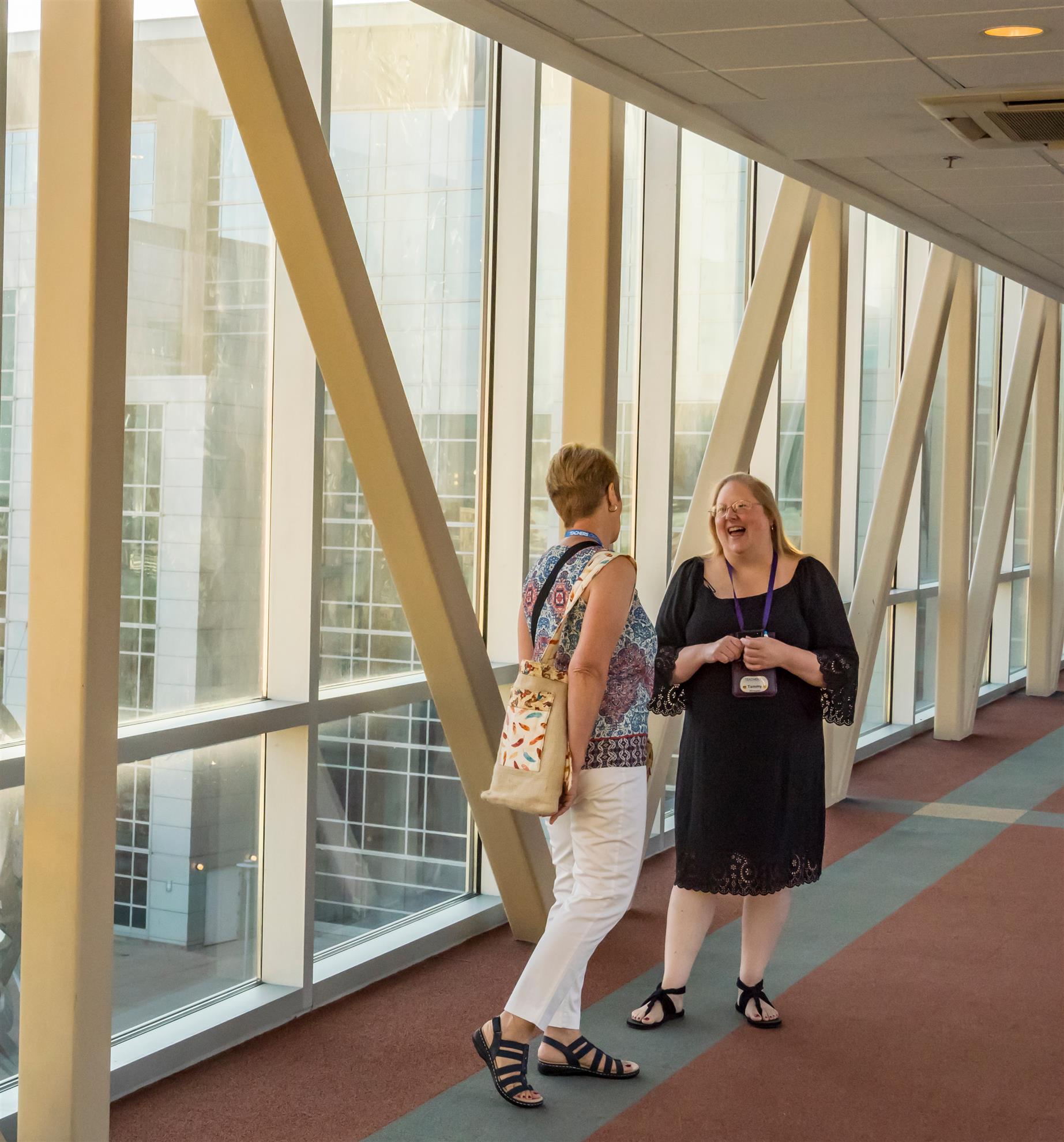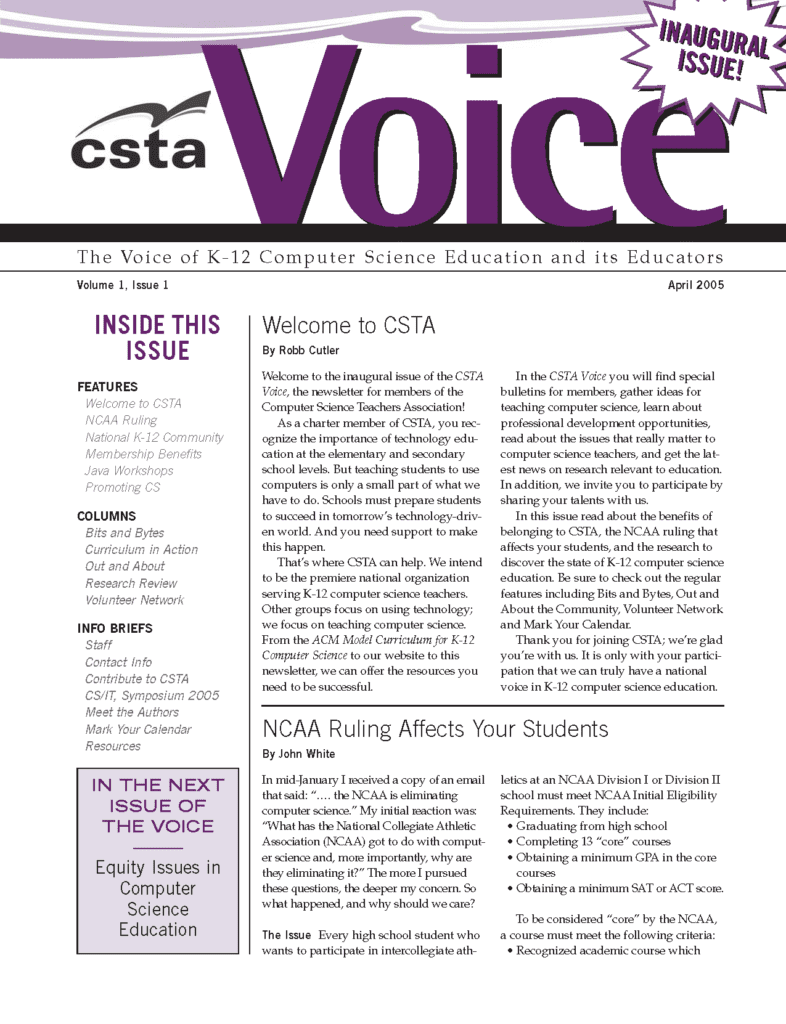“Welcome to CSTA.”
This is the title of the very first article, in the very first issue of The Voice, launched in April 2005.

The brainchild of former CSTA Executive Director Chris Stephenson, The Voice was an idea under construction before CSTA was a formally established organization. To bring her idea to life, Stephenson tapped Pat Phillips to serve as editor.
“It takes a special set of skills to be the editor of a newsletter for any organization, and especially for one that ran for so many years primarily on the goodwill and volunteerism of busy educators,” said Stephenson. “Not only did Pat write well and know how to edit text, she understood computer science education and our teacher audience. She was also super organized, patient, always generous in her praise and never harsh in her critiques, and willing to ask for things on behalf of the publication. She also had an unerring sense of the kind of topics teachers wanted and needed to know more about.”
Together, along with the CSTA Publication Committee, they set the objective to “create a membership newsletter to communicate CSTA organizational business” to be first published in April 2005. “The Voice was purposefully named because we wanted it to be both a voice for the growing organization but also to provide a voice for CS teachers,” Stephenson continued. “As our only editor, Pat masterfully kept exactly the right balance between these two goals.”
“Every new issue of The Voice was a window into computer science from across the country and around the world. I still remember the excitement of opening each issue and finally feeling like there was a world of CS education out there,” said current CSTA Executive Director Jake Baskin, “The first issue I read was about the 10th anniversary of the CSTA Annual Conference, and I can’t wait to celebrate the 20th later this summer.”
The Voice Through The Years
The look of The Voice has changed throughout the years, but the stories Phillips looked to share did not. It always centered around information computer science teachers needed to know about the field and about CSTA as an organization.
“Content used to be a lot more about buying a product or content versus things that are now cloud-based,” said Phillips. “There were articles about how to deal with physical things in your classroom.”
While a secondary source of content was from companies and organizations, it was the CSTA members who provided the best content. And what better place to talk to CSTA members than at the CSTA Annual Conference.
“I always used the conference as a great source of writers,” Phillips shared. “You’d find the best and the brightest at the conference and many of them are proud of their work and happy to write for you.”
“Pat has called on many of the Board members and others for information, contributions, and possible article authors, but she did the planning and put it all together (an enormous task),” recalls Fran Trees, who has served CSTA in many capacities.
“Like any good reporter, she was always on the lookout for a new story,” former CSTA committee member Doug Peterson said of Phillips, “I’d often get an email request for an ‘Update to Computer Science in Canada.’ Of course, in Canada, education is a provincial responsibility, but I could at least help out with what was happening in Ontario.”
 Requests, like the one mentioned by Peterson, allowed Phillips to create a theme for each issue. “We used to have themes for every issue. I would try to make the late summer issue back-to-school and include new tools, classroom lesson plans, and new ways to teach,” Phillips shared. “Sometimes the theme would come from [submissions]. I would collect them and save them until a theme emerged.”
Requests, like the one mentioned by Peterson, allowed Phillips to create a theme for each issue. “We used to have themes for every issue. I would try to make the late summer issue back-to-school and include new tools, classroom lesson plans, and new ways to teach,” Phillips shared. “Sometimes the theme would come from [submissions]. I would collect them and save them until a theme emerged.”Phillips did more than collect stories for, edit, and design The Voice—she manually folded and mailed the printed versions, too. While the manual work was time-consuming, it was worth it to Phillips.
“I found that very early on people were eager to see it in print – to see their names in print,” she said. “Teachers would submit articles and I would hear anecdotally that people couldn’t wait for it to come out in print so they could take it to show their principals. There weren’t the opportunities then that there are now to be published. Being published was a bigger deal and looked upon with self-pride. It was a way to set yourself above others.”
“I still have a binder of printed Voice articles,” said 2019 CSTA Annual Conference Chair Tammy Pirmann. “They used to come three-hole punched for a while. It was bittersweet when we moved to digital. The Voice was something we kept in our offices.”
Phillips, too, has a printed binder of every issue of The Voice – even the digital versions. “Having a folder tucked into the corner of your desktop labeled ‘past voice issues’ is not as satisfying to me as having a couple of albums on the coffee table I can look at.”
Phillips’ Contributions Span Larger Than The Voice
While Phillips is best known for her work on The Voice, her contributions to CSTA also include committee work. The relationships she’s developed over the years have left a lasting impression on those she connected with.
“Pat still is the person who people care about. She’s a person who really cares about others,” said Pirmann. “While I was going through chemotherapy and attending a CSTA Annual Conference, I couldn’t really eat the food offered. The nurturing person she is, Pat went off and found something that I could eat.”
Stephanie Hoepnner worked with Phillips on the Publications and Communication Committee and recalls her strong understanding of the way things needed to be presented depending on the message.
“The committee also worked on a rough draft of what a new website needed to look like to give to the designers,” said Hoeppner. “Again, Pat was able to take our thoughts and ideas and
articulate what was needed and why.”
 During our interview, Phillips shared many memories from CSTA Annual Conferences, but “The Doug and Pony Show” was one that quickly came to mind. The nickname for sessions, run by J. Philip East and Peterson, provided Phillips with many memories of laughter. It turns out she left quite an impression on them as well.
During our interview, Phillips shared many memories from CSTA Annual Conferences, but “The Doug and Pony Show” was one that quickly came to mind. The nickname for sessions, run by J. Philip East and Peterson, provided Phillips with many memories of laughter. It turns out she left quite an impression on them as well. “I think very few people have worked as hard for CSTA and [computer science education] as Pat. That certainly includes me,” said CSTA 2019 Volunteer of the Year J. Philip East. “I think she has never sought recognition for the work – she just did what was needed and did it very well.”
“Through her work as an editor, presenter, or just being a super-nice person to have a chat with, Pat represents the very best of connections that I’ve made through my association with the CSTA,” said Peterson.
Trees, who worked with Phillips on various CSTA committees and PD-related committees for more than 15 years, reflects on her character. “I can say that I admire and respect Pat for her belief that the important things in life aren’t things,” Trees said. “She shares stories and photos of her family, she loves the outdoors and values keeping fit and healthy, she is organized and structured in her work venues managing to complete everything she sets out to do. She is truly a role model for all of us.”
Building Upon The Voice‘s Foundation
After serving as the only editor of The Voice, Phillips retired in December to focus on other areas of her life. “I’ll miss meeting people who are excited about teaching,” she said. “I’ll miss the excitement and enthusiasm of teachers with a new idea.”
Phillips’ contributions will be missed at CSTA.
“On behalf of myself and the rest of the CSTA Board, I can’t thank Pat enough for her dedication to our organization,” said CSTA Board Chair Jennifer Rosato. “Her contributions to The Voice, CSTA’s standards and other projects are a large part of how we’ve been able to impact so many computer science teachers.”
“Through The Voice, Pat established a strong brand for CSTA and it’s one that we’ll continue to build upon,” added Baskin. “It will remain the resource for analysis, commentary and issues related to K-12 computer science education.”
For those who’ve worked with Phillips through the many iterations of The Voice, they see the publication as her legacy.
“Pat’s legacy is The Voice,” said Pirmann. “I think she lived it for so long. [What she created] in the stories we tell is there. It’s changed, but it’s not unrecognizable. The Voice is really her thing – it’s the real deal. It’s the communication we put out for CSTA. We put our other communications, but they don’t take the place of The Voice.”
Phillips hopes that you’ll allow CSTA to continue to tell your stories. “I hope [our members] will consider sharing their stories,” she said. “Sometimes it was difficult to find people who thought they had anything to offer. You just had to ask them how do you teach this, or what are your strategies for getting underrepresented people interested in computer science. There are endless things a teacher could share.”
“You have stories. Tell The Voice your stories and let whoever is editing to doll them up. Sharing your [experiences] can bring out great ideas from other people.”
Interested in sharing your story with The Voice? Read our submission guidelines.

